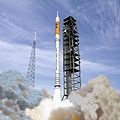File:Aiaa2.jpg
Appearance

Size of this preview: 600 × 600 pixels. Other resolutions: 240 × 240 pixels | 639 × 639 pixels.
Original file (639 × 639 pixels, file size: 84 KB, MIME type: image/jpeg)
File history
Click on a date/time to view the file as it appeared at that time.
| Date/Time | Thumbnail | Dimensions | User | Comment | |
|---|---|---|---|---|---|
| current | 15:18, 3 November 2008 |  | 639 × 639 (84 KB) | Aaaf-wiki~commonswiki | {{Information |Description={{en|1=JSC2008e039697, 2008 - The Ares I Crew Launch Vehicle is being developed at Marshall Space Flight Center in Huntsville, Alabama, and is a two-stage vehicle designed solely for carrying the Orion CEV to Earth orbit. The 9 |
File usage
The following 2 pages use this file:
Global file usage
The following other wikis use this file:
- Usage on ar.wikipedia.org
- Usage on de.wikipedia.org
- Usage on he.wikipedia.org
- Usage on hr.wikipedia.org
- Usage on nl.wikipedia.org
- Usage on nl.wikinews.org
- Usage on no.wikipedia.org
- Usage on ru.wikipedia.org
- Usage on sr.wikipedia.org
- Usage on tr.wikipedia.org


